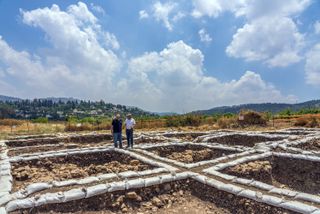Largest Neolithic Settlement in Israel Uncovered. Up to 3,000 People May Have Lived There.

Before it gets destroyed by a newly constructed highway, a 9,000-year-old Neolithic site just outside of Jerusalem is getting an exhaustive excavation, according to the Israel Antiquities Authority.
The humans who lived there during the Neolithic (the last period of the Stone Age) were a sophisticated bunch. Many of them were likely farmers who had stored hundreds of thousands of seeds — including lentils, chickpeas and beans — in storage facilities. These ancient people also kept domesticated goats, as shown by animal remains found at the site, and they traded with neighboring regions, such as what is now Turkey, Jordan and the areas around the Red Sea.
"This is the first time that such a large-scale settlement from the Neolithic period — 9,000 years ago — [has been] discovered in Israel," Hamoudi Khalaily and Jacob Vardi, archaeologists and excavation directors at the site, who work with the Israel Antiquities Authority, said in a statement. "At least 2,000 [to] 3,000 residents lived here — an order of magnitude that parallels a present-day city." [See Photos of the Neolithic Excavation]
Archaeologists have known about this location, called the Motza site, for decades. However, now that the government plans to build a new highway entrance and new roundabouts there, the Israel Antiquities Authority sent a team to do a full-scale excavation of the Neolithic settlement, Vardi told Live Science. This effort quickly became the largest excavation of a Neolithic site in the country, he said.
During the Neolithic, hunter-gatherer groups began farming and making permanent settlements. So, it came as no surprise when they found large buildings with rooms where Neolithic people once lived, public facilities and places for rituals. Alleyways ran between the buildings, showing that the settlement had an advanced layout. Some buildings even had plaster floors.
The team also uncovered human burials beneath and around the houses. Some of the burials also held burial goods, likely offerings that may have been given to help the deceased in the afterlife. Some of these grave goods came from far away — including obsidian beads from Anatolia (modern-day Turkey) and seashells from the Mediterranean Sea and Red Sea — indicating that the people at this site traded with neighboring regions.
The excavation also uncovered several stone and mother-of-pearl bracelets, which, given their small size, were likely worn by children or adolescents, Vardi said. He added that one burial showed that these bracelets were worn on the upper arm.
Sign up for the Live Science daily newsletter now
Get the world’s most fascinating discoveries delivered straight to your inbox.
The site also has thousands of stone arrowheads for hunting, axes for felling trees, and sickle blades and knives, as well as figurines whose styles date to the Neolithic. Radiocarbon dating of the seeds found at the site indicates that people lived there between 9,000 and 8,800 years ago, Vardi said. In addition to farming crops and keeping goats, these people kept cows and pigs; they also hunted game, such as gazelle, deer, wolves and foxes, as shown by animal remains found there.
"Based on the data that we have and from the fauna, we have a pretty good notion that the people at the site were farmers and they were specialists in what they did," Vardi said.
After the Neolithic period ended, people continued to live there. It's clear why this spot was so desirable, Vardi said, as it's near a large spring and several smaller springs that supply fresh water. The site is now 3.1 miles (5 kilometers) from Jerusalem, on the banks of the Sorek Stream. The entire Motza site is about 0.1 square miles (30 to 40 hectares).
As the excavation wraps up, the team still has a lot on its plate. The researchers plan to publish several papers and articles for the public on the site, as well as put some of the artifacts in museums for public viewing, Vardi said.
- Photos: Roadside Dig Reveals 10,000-Year-Old House in Israel
- Photos: 2,000-Year-Old Roman Road and Coins Discovered in Israel
- Back to the Stone Age: 17 Key Milestones in Paleolithic Life
Originally published on Live Science.

Laura is the archaeology and Life's Little Mysteries editor at Live Science. She also reports on general science, including paleontology. Her work has appeared in The New York Times, Scholastic, Popular Science and Spectrum, a site on autism research. She has won multiple awards from the Society of Professional Journalists and the Washington Newspaper Publishers Association for her reporting at a weekly newspaper near Seattle. Laura holds a bachelor's degree in English literature and psychology from Washington University in St. Louis and a master's degree in science writing from NYU.
Most Popular

